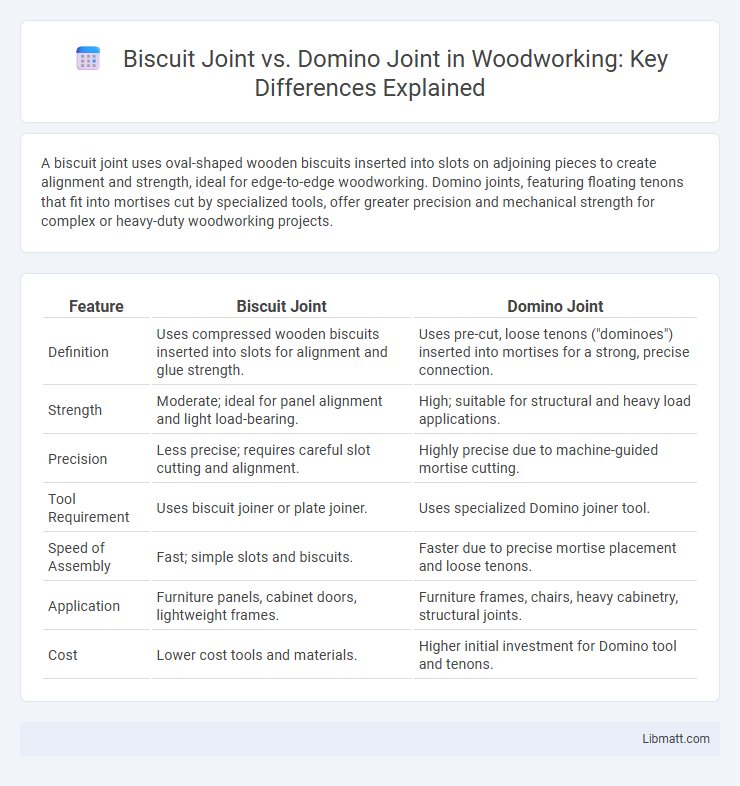A biscuit joint uses oval-shaped wooden biscuits inserted into slots on adjoining pieces to create alignment and strength, ideal for edge-to-edge woodworking. Domino joints, featuring floating tenons that fit into mortises cut by specialized tools, offer greater precision and mechanical strength for complex or heavy-duty woodworking projects.
Table of Comparison
| Feature | Biscuit Joint | Domino Joint |
|---|---|---|
| Definition | Uses compressed wooden biscuits inserted into slots for alignment and glue strength. | Uses pre-cut, loose tenons ("dominoes") inserted into mortises for a strong, precise connection. |
| Strength | Moderate; ideal for panel alignment and light load-bearing. | High; suitable for structural and heavy load applications. |
| Precision | Less precise; requires careful slot cutting and alignment. | Highly precise due to machine-guided mortise cutting. |
| Tool Requirement | Uses biscuit joiner or plate joiner. | Uses specialized Domino joiner tool. |
| Speed of Assembly | Fast; simple slots and biscuits. | Faster due to precise mortise placement and loose tenons. |
| Application | Furniture panels, cabinet doors, lightweight frames. | Furniture frames, chairs, heavy cabinetry, structural joints. |
| Cost | Lower cost tools and materials. | Higher initial investment for Domino tool and tenons. |
Introduction to Biscuit Joint and Domino Joint
Biscuit joints use small, football-shaped wooden pieces inserted into slots cut in two adjoining boards, providing alignment and moderate strength in woodwork. Domino joints employ larger, loose tenons shaped like elongated biscuits, inserted into mortises made by specialized Domino joiners, offering superior precision and structural integrity. Both techniques enhance edge joining but differ in tool requirements and joint strength.
What is a Biscuit Joint?
A biscuit joint is a woodworking technique that uses small, oval-shaped wooden "biscuits" inserted into matching slots cut into two pieces of wood to create a strong, aligned connection. This method is highly favored for edge-to-edge joining of panels, ensuring durability and precise alignment in cabinetry and furniture making. Your woodworking projects benefit from biscuit joints due to their ease of use and the invisible, seamless finish they provide.
What is a Domino Joint?
A Domino joint utilizes a specialized tool called the Domino joiner, which cuts precise, elliptical mortises for loose tenons, providing strong alignment and structural integrity in woodworking projects. Unlike biscuit joints that use flat, football-shaped biscuits, Domino tenons are rectangular, allowing for greater gluing surface and mechanical strength. This joint method is favored for its speed, accuracy, and superior holding power in cabinetry and furniture making.
Tools and Equipment Required
Biscuit joints require a biscuit joiner, a specialized power tool designed to cut precise slots in wood edges for inserting oval-shaped wooden biscuits that enhance alignment and strength. Domino joints utilize a Festool Domino mortiser, which creates mortises for loose tenons, offering greater precision, durability, and a more robust mechanical connection compared to biscuits. Both tools necessitate clamps to secure workpieces during assembly, but the Domino mortiser is generally more expensive and preferred for professional woodworking projects demanding superior joint strength.
Strength and Durability Comparison
Biscuit joints rely on oval-shaped wooden biscuits inserted into matching slots, providing moderate strength and alignment for light to medium load furniture projects. Domino joints use floating tenons made from robust hardwood, offering superior strength and durability suitable for heavy-duty applications and long-lasting structural integrity. Your choice between biscuit and Domino joints should depend on the specific load requirements and longevity needed in your woodworking project.
Speed and Ease of Use
Biscuit joints offer faster alignment with simple slots and require minimal setup, making them ideal for quick edge-to-edge wood joining. Domino joints, using floating tenons and a precise mortiser, provide slightly more complex setup but result in stronger, more accurate connections. Both methods enhance workflow efficiency, but biscuits excel in speed and ease of use for straightforward projects.
Alignment and Accuracy
Biscuit joints provide moderate alignment by fitting oval-shaped wooden biscuits into corresponding slots, helping to keep edges flush during glue-up but requiring precise slot cutting for optimal accuracy. Domino joints use loose tenons inserted into mortises created by a specialized DOMINO joiner, offering superior alignment and accuracy due to the machine's consistent and repeatable cutting depth and position. Choosing domino joints enhances your woodworking projects with stronger, more precise joints, reducing manual adjustments and ensuring consistent results.
Cost and Accessibility
Biscuit joints generally offer lower costs due to inexpensive tools and readily available biscuits, making them accessible for hobbyists and small workshops. Domino joints require a specialized Festool Domino joiner, which has a higher upfront investment but provides stronger, quicker connections suited for professionals. Your choice depends on balancing budget constraints with the need for precision and durability in woodworking projects.
Common Applications and Suitability
Biscuit joints excel in edge-to-edge wood joining, commonly used in cabinet making, furniture assembly, and panel alignment due to their strong alignment and ease of use. Domino joints offer superior strength and versatility, ideal for load-bearing furniture, cabinetry, and frames where precision and durability are critical. Both joints suit woodworking projects requiring strong alignment, but domino joints are preferred for heavier-duty applications and complex joinery.
Which Joint Should You Choose?
Choosing between a biscuit joint and a domino joint depends largely on the project's requirements for strength, alignment, and speed of assembly. Biscuit joints offer moderate alignment accuracy and quick installation with standard woodworking tools, making them ideal for edge joining and lighter applications. Domino joints provide superior strength and precise alignment through their mortise and tenon design, suitable for heavy-duty woodworking and furniture construction requiring long-lasting durability.
Biscuit joint vs Domino joint Infographic

 libmatt.com
libmatt.com